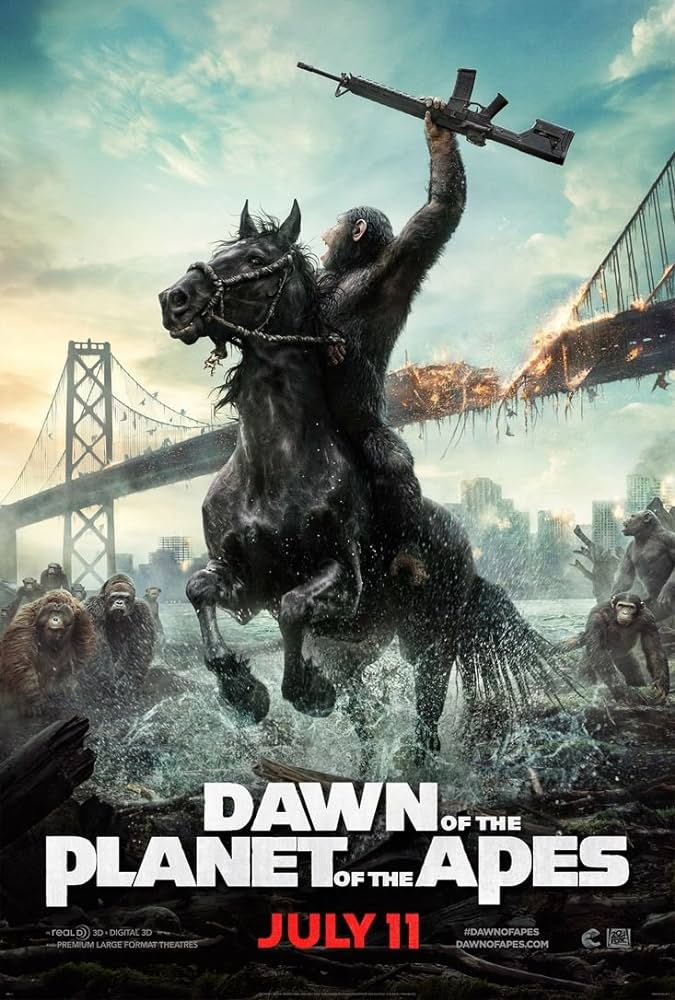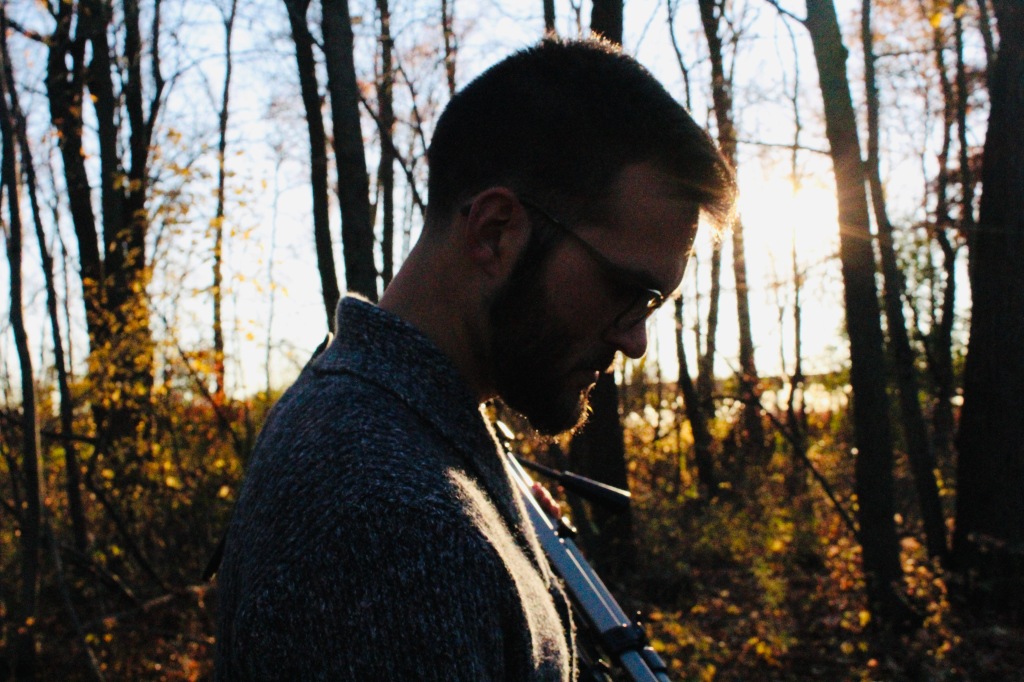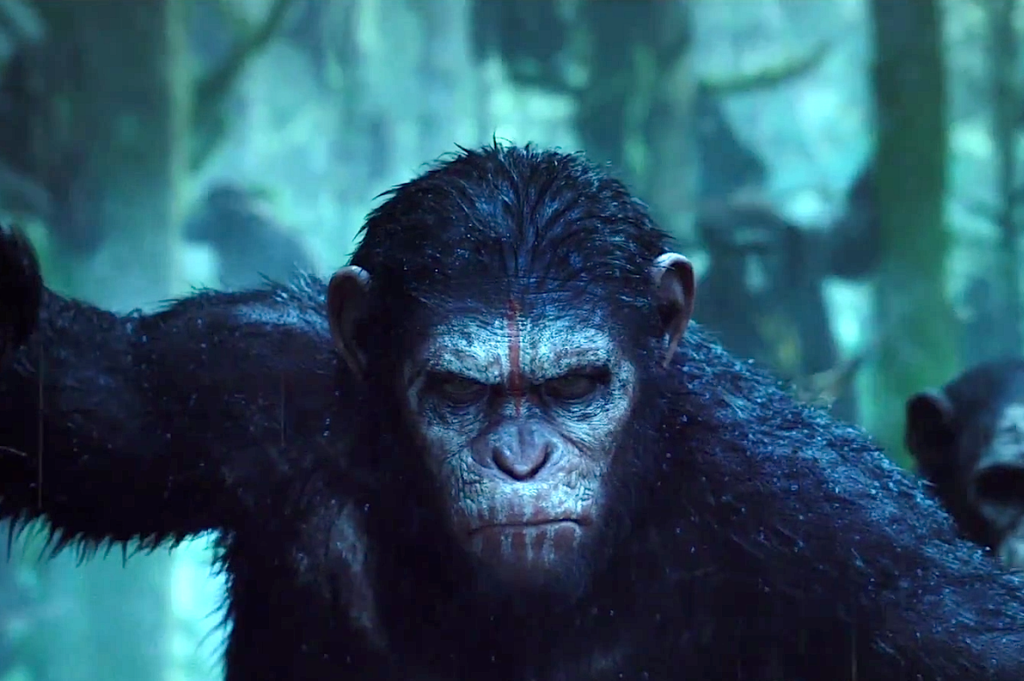Dawn of the Planet of the Apes is a 2014 dystopian science-fiction film from writer-director Matt Reeves and stars Andy Serkis doing motion-capture for lead ape Caesar.
I’ve heard about the “Planet of the Apes” remake trilogy for years. Featuring Rise of the Planet of the Apes from 2011, Dawn from 2014, and War for the Planet of the Apes in 2017, the trilogy has been lauded both for their lifelike special effects and their moving story.
Rise, the first film, was directed by Rupert Wyatt. Dawn and War were both written and directed by Matt Reeves and are much more interconnected than Rise is to them. I actually haven’t seen Rise, but heard that Dawn could be watched on its own. Rise isn’t on any streaming platforms that I know of right now, so rather than waiting for my Max subscription to expire in a month, I watched Dawn now.
I wasn’t disappointed. Dawn is one of the best movies I’ve seen in a long time, a balance of spectacle on a grand scale you crave from Hollywood with a moving and thoughtful story that inspires and always undergirds the spectacle. The characters are spectacular – both animated and live action. The worldbuilding is interesting and reflective, baring a hiccup here or there. There is simply so much going on in this movie, and it balances them all so well.

A Brief Synposis
In Rise, the first movie in the trilogy, Will was experimenting with a cure for Alzheimers on chimpanzees. The cure gave a few chimpanzees, including their leader Caesar, advanced intelligence. It also spread an infectious disease across the world that left a dark shadow of the ending.
Ten years later, the world has completely fallen apart. Billions are dead. Grass and trees and vines grow over haunted cities. Caeser leads a community of intelligent apes in the Muir Woods National Monument outside San Francisco. Some can speak chopped sentences, while all can perform sign language. They’ve created a settlement with log walls, a kind of schooling, and hunting. They haven’t seen humans in two years. Caesar rules with his young son Blue Eyes and his more aggressive but respecting companion Koba.
When a search party from the community reorganized in San Francisco, led by Malcolm, tries to restart the hydroelectric dam near the Muir Woods, they run into the apes. The next two hours are a tense back-and-forth as the humans, guided by protective Dreyfus and peacekeeping Malcolm, attempt to restart the dam under skeptical alpha Caesar’s and formerly tortured Koba’s supervision. Koba believes Caesar is being weak and loving the humans instead of protecting his own. The tension is simmering over.
What will happen?

The Successes
This movie is better than it has any right to be. Rarely are sequels, prequels, or reboots as good as the original, or even better. Yet somehow, these prequels to the classic Planet of the Apes movie (I haven’t watched anything beyond the original, but I hear that they don’t match its quality) are spectacular in their own right. They are original and fresh yet tell the most compelling of tragedies on societal scales.
This movie is an examination of the interaction of societies. Why does war escalate? How does fear get in the way of not just surviving, but thriving? How does society develop after catastrophe? How does a society develop in the first place, as roles and language develop? How do people give in to fear, like Carver, whose first reaction toward seeing an ape is pulling a gun out, who keeps an extra gun when the apes specifically told them no? The movie is fascinating for that alone. It isn’t a case of good and evil. It’s a case study on our world, how fighting and war start, how the worst intentions are assumed. While this world is fantastical, it is also our world.
Every character – Dreyfus, Malcolm, Koba, Blue Eyes, and especially Caesar – is understandable. You get Dreyfus’ fear at the apes. You understand Koba’s total mistrust of the humans. You get Blue Eyes’ need to prove himself. You are in awe along with Malcolm. You are skeptical with Caesar. You are along for the ride and see why everybody is doing what they’re doing. There are really no villains. Yes, Kona and Dreyfus stand in the way of peace, but their viewpoint is completely understandable. While these characters are fantastical, they are also us.
Another success is the pacing. The movie never lets up on the gas since the first humans and apes run into each other. You don’t even see the humans until 10 or so minutes in, after falling in love with the world of the apes. It slowly builds up this world, and then the avalanche begins. Tension, release, tension, release, tension, release – always a new problem, a new situation, a obstacle. You’re never ready for when they appear, but suddenly they do. You’re always ready for the next disaster to strike. But what’s funny is that there really are few action scenes in this movie. There’s one small duel, the invasion of San Francisco, and the final fight. Other than that, it’s not really an action movie. It plays more like a war thriller, tension constantly simmering under the surface, but occasionally bursting and bubbling to the surface. While the action is fantastical, it is also always for a purpose.
A moment here to spend on a few hiccups, though. Starting the dam is considered a huge necessity for two reasons: 1) that they would get power before their generators run out in three weeks, and 2) the San Francisco colony can radio the outside world. However, they have generators and gasoline. Why not just radio the outside world with the power of those generators? Secondly, wouldn’t the power lines be so corroded from somewhere around 10 years of disuse, leading to months of repairs to get the power to the city anyways? Those two stand out to me as silly in particular. Maybe they found cable to wire to the edge of the city, and they’ve already set that up… a few lines would be all it would take to fix those two. But I digress. The rest of this movie follows so sadly logically from one point to the next as the humans and apes interact, and I’ll forgive those two for the sake of the drama that unfolds.

The Greatest Triumph
The greatest triumph, however, is the special effects.
My goodness, this movie is glorious.
I mean, just look at the face of Caesar up above, in an actual scene from the movie. The amount of detail on his face, in his fur, in his eyes, is just simply outstanding.
Barring a few mid-distance shots where you can tell the CGI, the apes look absolutely real. Whether it’s swarms of apes jumping through the forest, the home of the apes teeming with them, individual interactions with apes and humans, or this glorious tank fight one shot that’s considered one of the best special effects shots of all time. Maurice, the friendly orangutan, is the most impressive special effects wise, mostly because every. Single. Shot he is in he looks 100% real. Occasionally for other characters there is a lapse where you can see the flaws. Not Maurice. He is stunningly flawless. The special effects are worth the price of admission alone.
You’ll be dazzled by the spectacle, from the ape’s invasion of San Francisco, to the final battle, to the burning of the home of the apes. There’s always something to fill your screen and to make your jaw drop.
The technology behind this film is incredible. Which this behind the scenes to truly get a glimpse on how special this movie is, and this video as one of the team leaders of the effects breaks down his work in Rise, Dawn, and War. From the pioneering outdoor motion capture technology, to the hair simulation, to the complete overhaul of real-life environments with CGI so good you don’t even notice, this movie is a master class in digital effects from Weta Workshop, probably the second greatest and most influential digital effects company of all time behind Lucasfilm and Skywalker Sound (although Lucasfilm has much less impact today than Weta does now).
But what’s even more impressive is that these effects and technology serve the characters. Every micro-expression that Andy Serkis has while playing Caesar is communicated into the ape’s face. Every detail of Maurice is so that his human interactions melt your heart. It’s all so that you come to care for Casear, and Maurice, and Caesar’s son Blue-Eyes, and the other apes. You care about them. You learn to read their oh-so-similar but oh-so-different faces to ours. You see their struggles as they try to make hard decisions that humans can’t even maneuver, let alone intelligent apes that can sort-of speak. Every expression, ever slight raise of the body or the arms, tells you so much about each situation and character. The special effects aren’t just fluff. They’re being used by an incredible story.
Sometimes people rant on and on about CGI–computer generated imagery. It’s the worst thing that could have happened to movies. While I can’t comment on every use of CGI, I know this story would not exist without its CGI special effects. Isn’t that worth something?
Story and Effects
The most amazing part of Dawn of the Planet of the Apes is not the special effects, but that these special effects are wrapped around the heartbreakingly interesting story of one of the best Science Fiction movies of all time.
This story would not exist without these effects. And movies are all the better for it.

𝙷𝚒! 𝙼𝚢 𝚗𝚊𝚖𝚎 𝚒𝚜 𝙽𝚊𝚝𝚑𝚊𝚗. 𝙸’𝚖 𝚊 𝚐𝚛𝚊𝚍𝚞𝚊𝚝𝚎 𝚜𝚝𝚞𝚍𝚎𝚗𝚝 𝚠𝚑𝚘 𝚕𝚘𝚟𝚎𝚜 𝚜𝚝𝚘𝚛𝚢𝚝𝚎𝚕𝚕𝚒𝚗𝚐, 𝚕𝚎𝚊𝚛𝚗𝚒𝚗𝚐, 𝚊𝚗𝚍 𝚌𝚛𝚎𝚊𝚝𝚒𝚗𝚐, 𝚊𝚗𝚍 𝚊𝚕𝚜𝚘 𝚕𝚘𝚟𝚎𝚜 𝚝𝚘 𝚝𝚊𝚕𝚔 𝚊𝚋𝚘𝚞𝚝 𝚝𝚑𝚎𝚖 (𝚜𝚘𝚖𝚎 𝚠𝚘𝚞𝚕𝚍 𝚜𝚊𝚢 𝚝𝚘𝚘 𝚖𝚞𝚌𝚑!) 𝙵𝚘𝚕𝚕𝚘𝚠 𝚝𝚑𝚒𝚜 𝚋𝚕𝚘𝚐 𝚝𝚘 𝚜𝚎𝚎 𝚖𝚘𝚛𝚎 𝚌𝚘𝚗𝚝𝚎𝚗𝚝!


Leave a comment